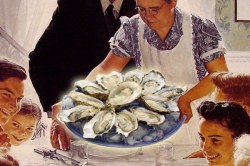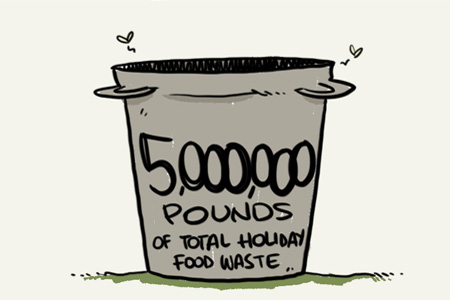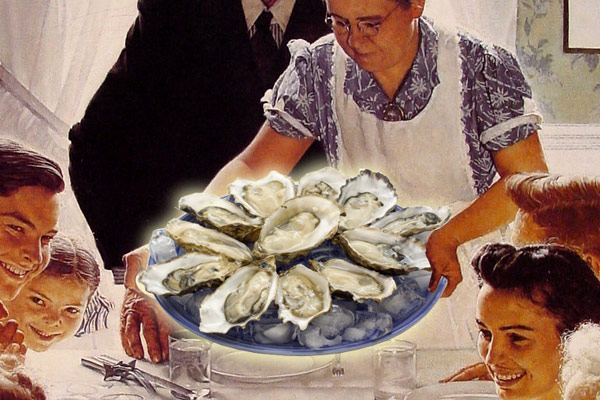
Grist / ShutterstockNow here’s something everyone can enjoy.
Imagine, if you will, a Thanksgiving table of plenty not anchored by a meaty, glistening bird. In its place of honor, rather, sits a bowl of sea-chilled, slimy oysters. No? Don’t like that? How about a plank of grilled salmon? Venison steak? Mushroom casserole?
Heresy it may seem, but perhaps defaulting to the time-honored turkey isn’t the best choice when planning Thanksgiving dinner. After all, many greenies spend the other 364 days of the year caring deeply about how sustainable, humane, and local their meals are. Why should a Thursday in November be any different? Why shouldn’t we examine our menu choices more closely before going with the venerated poultry?
To tell the truth, I love traditional holidays almost as much as I love a good turkey breast. But this year, I decided to do some digging to find out if any other main dishes could beat out the old gobble-gobble when it comes to eco-friendliness.
The criteria for judging contenders for my holiday table are as follows: The dish must be sustainable — that is, farmed, hunted, or gathered in a way that minimizes pollution and other harmful environmental impacts, plus preserves the population of the food in question. It must be humane. It must be local, to reduce shipping-related carbon. It must be as healthy as possible. Cost and flavor will be considered as a secondary factor. Also, the dish needs to have a low risk of me accidentally shooting myself in its pursuit — so that means game like wild turkey, deer, bobcat, moose, and mountain goat are out. (All of which you can hunt in the great state of Washington, where I live.)
So, what should be on my menu for the greenest Thanksgiving possible? Here are the results, in ascending order.
7. Conventional turkey
Surprise! The regular old grocery-store turkey was the hands-down worst option. The vast majority of holiday birds are Broad Breasted Whites, genetic mutants that can’t reproduce on their own, and are often factory-farmed. In fact, on the Disturbing Scale©, the lives of typical birds are right up there with The Silence of the Lambs and this Michael Jackson baby doll. Automatic DQ.
6. Mushrooms
You might think that in the soggy, ‘shroom-infested Northwest, a bounty of fungi would make for the perfect main dish. But putting aside the fact that sending my mycologically uneducated self traipsing into the woods with a picnic basket is an invitation for projectile vomiting at best (and, ya know, death at worst), this isn’t a great time for mushrooming. The choicest bits are all a significant drive away this time of year, not that I would be able to identify them anyway; and a dry fall made for a crappy ‘shroom season.
So wild mushrooms are tougher to find, but let’s also consider their nutritional value: kinda minimal. I know they’re considered a vegetable and all, but mushrooms provide just traces of protein and fiber, plus a handful of vitamins and minerals. Not bad for a side dish, but America, we can do better.
5. Geoduck
Oh please. Don’t let it be the geoduck.
If you’ve ever seen this two-pound abomination of a mollusk, you’ll understand my aversion to setting one out on the holiday spread. But it must be considered: The burrowing geoduck is “extremely abundant” in Puget Sound, and harvesting it has a negligible environmental impact — in fact, wild-caught gooeys earn a “Best Choice” rating from the Monterey Bay Aquarium. And, uh-oh: They’re a great, low-fat source of iron, protein, and vitamins, plus, hey, they’re tasty.
But wait: Here, geoducks are only catchable during the extremely low tides of spring and summer. Whew. I really didn’t want to explain to my friends why our holiday feast comes in Dirk Diggler-sized portions. Plus, snagging a geoduck is really, really hard.
4. Salmon
Here’s a promising candidate! Hearty, healthy, delicious, and practically the patron saint of the Pac NW — give me a reason not to serve salmon for Thanksgiving! Well, turns out that Washington coast salmon face habitats threatened by pollution, development, and dams, and local populations have declined quite a bit. Oh, and they might be high in PCBs. The fleshy fish is doing much better in Alaska … but that’s not exactly local, is it?
TIE for 2. Dungeness crab
S’ok, I like crab, too, and the mighty Dungeness delivers in the culinary-drama department. This local species also bears a “Best Choice” stamp: Fishing management out here is considered top-notch, with strict rules about harvesting only males that are big enough to have bred already. Because they’re caught in small, individual traps, the risk of unintentionally massacring loads of other sea creatures is very low (bycatch, for you salty dogs). Dungeness crabs grow quickly and reproduce like the dickens, making the population very resilient to fishing pressure.
Also consider: Crab meat is pretty healthy (high in protein and low in saturated fat; and while it does score higher on cholesterol, it still ranks under eggs). Crab meat is also expensive. At one large Dungie per person, we’d be looking at roughly $180 to feed six.
TIE for 2. Heritage turkey
It cheers my heart to learn that it’s possible to eat turkey with a clear conscience after all. But it’s gotta be a true heritage bird from a local operation, where the breeds are hearty, turkeys can actually walk, and life is lived under the open sky. Luckily, several such farms exist in my area (though you’ve got to order well ahead of time).
Turkey also kills it on the nutrition front: lean, high in protein, and a good source of iron, zinc, and B vitamins. But it’s pricey, to the tune of $8 or more per pound (where you can grab a conventional turkey for $2 or less per pound). Still, turkey gets a boost simply from the weight of tradition. In fact, visions of the Pilgrims chowing down on a giant drumstick would push this one to the top, except …
1. Oysters
Except for the oysters. Briny, gray, and the consistency of a cold booger, calling these bivalves an acquired taste is like saying Michael Jordan was OK at layups. But hear me out: First of all, Puget Sound is lousy with famed oyster farms — operations so well-run they also earn the coveted “Best Choice” designation [PDF].
And because oyster “farming” essentially involves plopping the mollusks into the sea and letting them grow to maturity, these farms have a very small environmental impact — even smaller if said oysters mature in cages positioned off the sea floor, which don’t require dredging to harvest. Plus, farmed oysters have a very low chance of striking out on their own to wreak havoc on a delicate native ecosystem. This is probably due to the fact that they don’t have arms or legs, and cannot move on their own. (Damn! Now what am I going to do with this 200-page screenplay for Oyster Run?)
But here’s the kicker: Not only does oyster farming do minimal harm to the ocean, it actually helps water quality. That’s right, these little filter feeders skim nutrients, plankton, and bacteria out of the waves, resulting in better coastal water conditions. A basically healthy (high in protein, iron, and a bunch of vitamins and minerals, if a bit cholesterol-laden), coveted delicacy with a net positive eco-impact? Ladies and gents, we have a winner.
Disgusted? I hear you — I used to think oysters were vile little stomach bombs on the half shell, too. But when I moved to Seattle, I tried another one, and another, and suddenly, the wide world of delicate flavors and ocean terroir revealed itself to me. They’re intense — I can usually only handle about three at any one sitting — but to my surprise, I now actually love them.
I hope my guests do, too. Happy Thanksgiving, everyone, and happy slurping!



